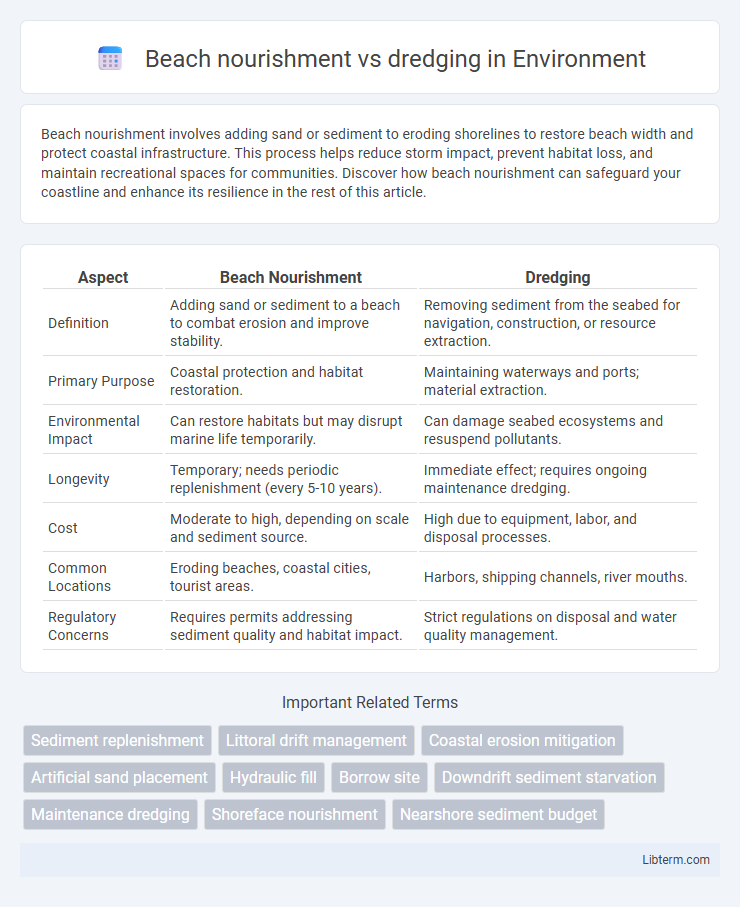Beach nourishment involves adding sand or sediment to eroding shorelines to restore beach width and protect coastal infrastructure. This process helps reduce storm impact, prevent habitat loss, and maintain recreational spaces for communities. Discover how beach nourishment can safeguard your coastline and enhance its resilience in the rest of this article.
Table of Comparison
| Aspect | Beach Nourishment | Dredging |
|---|---|---|
| Definition | Adding sand or sediment to a beach to combat erosion and improve stability. | Removing sediment from the seabed for navigation, construction, or resource extraction. |
| Primary Purpose | Coastal protection and habitat restoration. | Maintaining waterways and ports; material extraction. |
| Environmental Impact | Can restore habitats but may disrupt marine life temporarily. | Can damage seabed ecosystems and resuspend pollutants. |
| Longevity | Temporary; needs periodic replenishment (every 5-10 years). | Immediate effect; requires ongoing maintenance dredging. |
| Cost | Moderate to high, depending on scale and sediment source. | High due to equipment, labor, and disposal processes. |
| Common Locations | Eroding beaches, coastal cities, tourist areas. | Harbors, shipping channels, river mouths. |
| Regulatory Concerns | Requires permits addressing sediment quality and habitat impact. | Strict regulations on disposal and water quality management. |
Introduction to Beach Nourishment and Dredging
Beach nourishment involves the placement of sand or sediment along eroding shorelines to restore beach width and protect coastal infrastructure. Dredging is the process of removing accumulated sediments from water bodies to maintain navigable waterways, often providing material for beach nourishment projects. Both techniques are essential coastal management strategies to address erosion, support marine habitats, and enhance shoreline resilience.
Defining Beach Nourishment: Methods and Purposes
Beach nourishment involves the addition of sand or sediment to eroding shorelines to restore beach width and protect coastal infrastructure, using methods such as truck delivery, hydraulic pumping, or dredge placement. This process aims to enhance coastal resilience against storm damage, prevent erosion, and improve recreational beach areas. Unlike dredging, which primarily focuses on deepening waterways for navigation or resource extraction, beach nourishment specifically targets shoreline stabilization and habitat restoration.
Understanding Dredging: Techniques and Applications
Dredging involves the removal of sediment and debris from the bottom of water bodies to maintain navigable waterways, prevent flooding, and support construction projects. Common techniques include cutter suction dredging, hydraulic dredging, and mechanical dredging, each selected based on sediment type and project goals. Applications range from deepening harbors and rivers to acquiring sand for beach nourishment, ensuring coastal protection and environmental management.
Environmental Impacts of Beach Nourishment
Beach nourishment involves adding sand to eroding beaches, which enhances coastal protection and habitat restoration but can disrupt local ecosystems through sediment smothering and altered water quality. The process may temporarily harm marine life, including benthic organisms, due to changes in substrate composition and increased turbidity. Despite these impacts, beach nourishment is often considered more environmentally sustainable than dredging, which physically removes seabed material and poses greater risks of habitat destruction and water contamination.
Environmental Impacts of Dredging
Dredging involves the removal of sediments from the seabed, which can lead to habitat destruction, increased turbidity, and the release of pollutants, negatively impacting marine ecosystems. This process disrupts benthic communities and can alter water quality, causing stress to aquatic flora and fauna. In contrast, beach nourishment generally adds sediment to shorelines with less extensive disturbance to underwater habitats.
Cost Comparison: Beach Nourishment vs Dredging
Beach nourishment typically involves lower upfront costs compared to dredging, since it focuses on adding sand to eroded shorelines using less intensive machinery. Dredging requires specialized equipment to remove sediment from underwater, resulting in higher operational and maintenance expenses. Long-term costs favor beach nourishment when sediment sources are nearby, while dredging often incurs significant transportation and disposal fees, impacting overall project budgets.
Long-Term Effectiveness and Sustainability
Beach nourishment provides a sustainable solution by replenishing sand and maintaining coastal ecosystems, promoting long-term shoreline stability. Dredging, while effective for deepening waterways and immediate erosion control, often disrupts marine habitats and may require frequent repetition, reducing its long-term sustainability. Combining strategic beach nourishment with careful dredging can enhance both effectiveness and environmental preservation over time.
Community and Economic Considerations
Beach nourishment enhances coastal resilience by replenishing sand, supporting tourism, and protecting property values, which fosters community stability and economic growth. Dredging, while essential for maintaining navigable waterways and ports, can disrupt marine habitats and water quality, potentially impacting local fisheries and coastal businesses. Balancing these methods requires assessing long-term community benefits and economic impacts, prioritizing sustainable practices that support both environmental health and economic vitality.
Regulatory and Permitting Challenges
Beach nourishment and dredging face complex regulatory and permitting challenges due to environmental impact assessments mandated by agencies such as the U.S. Army Corps of Engineers and the Environmental Protection Agency. Compliance with the Clean Water Act, Coastal Zone Management Act, and Endangered Species Act requires extensive documentation, public consultations, and mitigation plans to protect marine habitats and ensure sustainable sediment management. Navigating this regulatory framework often results in prolonged timelines and increased project costs, emphasizing the importance of early stakeholder engagement and thorough environmental impact studies.
Choosing the Best Solution for Coastal Protection
Beach nourishment replenishes eroded shorelines by adding sand, enhancing natural coastal defenses and supporting local ecosystems. Dredging removes sediments from waterbeds to maintain navigable waterways but can disturb marine habitats and requires careful disposal of dredged materials. Selecting the best solution for coastal protection depends on site-specific factors such as erosion rates, sediment availability, ecological impact, and long-term sustainability goals.
Beach nourishment Infographic

 libterm.com
libterm.com